10 hours ago
By India Bourke,Features correspondentShare https://www.bbc.com/future/article/20240425-how-dangerous-is-bird-flu-spread-to-wildlife-and-humans
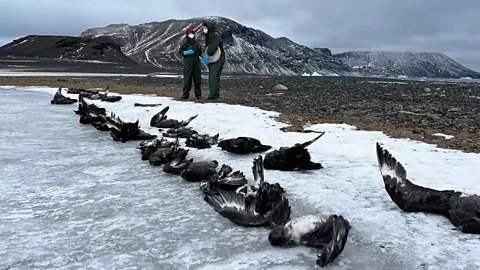 Ben Wallis(Credit: Ben Wallis)
Ben Wallis(Credit: Ben Wallis)
Bird flu is decimating wildlife around the world and is now spreading in cows. In the handful of human cases seen so far it has been extremely deadly.
The tips of Lineke Begeman’s fingers are still numb from a gruelling mission. In March, the veterinary pathologist was part of an international expedition to Antarctica’s Northern Weddell Sea, studying the spread of High Pathogenic Avian Influenza (HPAI), the virus that has now encircled the globe, causing the disease known as bird flu.
Cutting into the frozen bodies of wild birds that the team collected, Begeman was able to help establish whether they had died from the disease. The conditions were harsh and the location remote, far from her usual base at the Erasmus Medical Centre in the Netherlands. But systematic monitoring like this could provide a vital warning for the rest of the world.
“If we don’t study the extent of its spread now, then we can’t let people know what the consequences are of having let it slip through our fingers when it began,” Begeman tells BBC Future Planet. “I imagine the virus as an explorer going through the world, to new places and bird species, and we’re following it along.”
Relatively few people have caught the virus so far, but it has had a high mortality rate in those that do: more than 50% of people known to become infected have died.
 Antonio AlcamíAn expedition to the Antarctic’s Northern Weddell Sea has systematically studied bird flu’s spread in this remote, wildlife-rich region (Credit: Antonio Alcamí)
Antonio AlcamíAn expedition to the Antarctic’s Northern Weddell Sea has systematically studied bird flu’s spread in this remote, wildlife-rich region (Credit: Antonio Alcamí)
Moreover, the impact on animals has already been devastating. Since it was first identified, the H5 strain of avian influenza and its variants have led to the slaughter of over half a billion farmed birds. Wild-bird deaths are estimated in the millions, with around 600,000 in South America since 2023 alone – and both numbers potentially far higher due to the difficulties of monitoring. At least 26 species of mammals have also been infected.
In Antarctica’s Northern Weddell Sea, Begeman and her colleagues sampled around 120 carcasses from different species, including several Antarctic fur seals. The virus was detected at four of the 10 sites they visited.
It was not the first time bird flu had been detected on this remote continent. That first case was a month prior, in February 2024. But theirs was the first confirmation from this particular region, and the first time, Begeman believes, that a multidisciplinary team had set out to systematically determine its Antarctic spread.
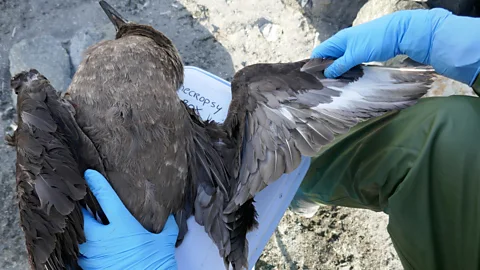 Matteo LervolinoMillions of wild birds are estimated to have died from the spread of high pathogenic avian influenza (Credit: Matteo Lervolino)
Matteo LervolinoMillions of wild birds are estimated to have died from the spread of high pathogenic avian influenza (Credit: Matteo Lervolino)
“The moment we found the first evidence of that destructive serial killer virus amidst such a bird-rich, pristine area, we realised what disaster is about to happen and it became sickening indeed,” says Begeman.
Already the worst bird flu outbreak in wildlife on record, scientists like Begeman are now racing to track its journey – and so better understand how its further spread among humans might be stopped.
Where does bird flu come from?
China’s southern Guangdong region is a mosaic of lakes, rivers and wetlands. These watery habitats are well suited to aquatic birds, who are natural hosts for low pathogenic avian flu. And it was here, in 1996, that a farmed goose became the world’s first bird to be diagnosed with a new, highly pathogenic strain of the virus, known as H5N1.
The categorisation of bird flu as low or high pathogenic was established in relation only to chickens, not to other bird (or mammal) species. But whereas low-path avian influenza is non-fatal in wild birds and only causes mild disease in chickens, in poultry, low path strains can mutate into fatal high-path ones, causing severe illness and often death.
People are the real problem – Thijs Kuiken
It should be no surprise that the highly pathogenic virus’s first case was detected on a poultry farm, says Thijs Kuiken, a comparative pathologist at Erasmus University Medical Centre in the Netherlands. “High pathogenic avian influenza is typically a poultry disease, which doesn’t occur in the wild. What’s unusual now, is this particular type has spilled into wild birds and this has allowed it to spread worldwide.”
Although wild birds have now helped the virus reach far beyond China, “people are the real problem”, Kuiken warns. And in particular, humanity’s ever-rising demand for farmed meat.
When this outbreak started in 1996, there were around 14.7 billion poultry birds in the world, mostly chickens. Now there’s double that number. “Biomass-wise, poultry currently forms over 70% of all avian biomass worldwide,” Kuiken notes.
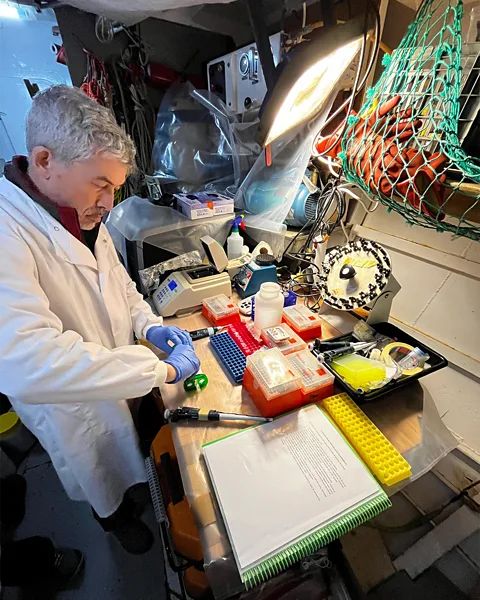 Ben WallisAn on-board laboratory allowed a scientific expedition to Antarctica to test and confirm bird flu’s presence in situ (Credit: Ben Wallis)
Ben WallisAn on-board laboratory allowed a scientific expedition to Antarctica to test and confirm bird flu’s presence in situ (Credit: Ben Wallis)
If the current poultry farming trends don’t change, then “other highly infectious pathogens will continue to spread into the few wild birds remaining,” Kuiken says. House finches, for instance, are proving particularly susceptible to a bacterial poultry disease, Mycoplasma gallisepticum. Virulent strains of Newcastle disease are also crossing over into multiple species, including parrots and macaws. “HPAI [high-pathogenic bird flu] is only one threat.”
How did bird flu spread around the world?
By 2005-06 the virus had spilled over into wild birds and was travelling as far as Europe, Africa and the Middle East, but it was disappearing in these populations after only a few months – likely a combination of not spreading well enough in wild birds, not surviving well enough in water, and some birds developing immunity, says Kuiken. This helped to limit the extent of its impact and its ability to further mutate.
H5N1 timeline
1996: detected in poultry in Guangdong, China
1997: first human deaths in Hong Kong
2005: Spilled over into wild birds in a major way. New strains emerge.
2020: A strain emerges that can sustain in wild bird populations year-round
2020-22: Becomes endemic in wild bird populations
2021: Arrives in North America
2022: Detected in South America
2024: Confirmed in Antarctica
That relative containment changed in 2020, however, when a new strain of H5N1 emerged. Though it’s not known exactly why, the strain could maintain itself in wild bird populations year-round. Now able to spread during springtime when birds gather in high densities to breed, the virus rapidly became endemic in wild bird populations.
In late 2021, the virus arrived in the New World via Canada’s eastern Newfoundland province. A black-backed gull, found sick in a pond, was taken to a wildlife rehabilitation centre where it died the following day. It was later found to be positive for H5N1. Days after its death, a poultry farm started reporting increased mortality rates and autopsies also confirmed presence of the virus.
The fact there was no evidence this farm had imported poultry from Europe helped to confirm scientists’ theories that wild birds’ migration routes are the key long-distance carrier, explains Kuiken. There have been some exceptions, however, such as the transport of infected turkeys from the UK to Europe.
It’s like avoiding getting into a packed metro when you’re already sick – Gregorio Torres
By 2022, birds in colonies from the UK to Israel were dying in their thousands. In October 2022, the virus was detected in wild birds on the west coast of Peru and Chile. After travelling down the coast, it then returned up the east, spreading to the Falkland Islands and South Georgia – the stepping stones to the Antarctic.
Along this route, the virus has diverged to infect a wide variety of mammals – including 21 species in the US alone. And with such cross-over, the opportunity for both human contact and mammal-to-mammal spread has increased.
By 16 April 2024, HPAI was confirmed in dairy cows on 26 farms in the US, from Texas to Michigan. Some of these may have been infected through wild birds, but other cases have been connected to cows’ long-distance transport. So far, only one case of cow-to-human infection is thought to have occurred, and the virus may require several more mutations beforeit can spread easily between people.
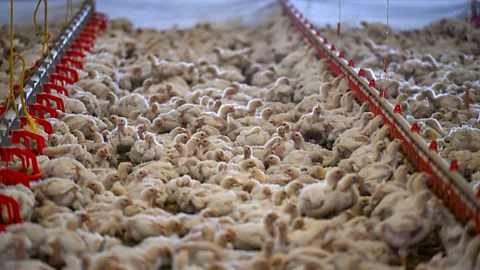 Getty ImagesFarms are being urged to deploy biosecurity measures in the wake of bird flu’s spread (Credit: Getty Images)
Getty ImagesFarms are being urged to deploy biosecurity measures in the wake of bird flu’s spread (Credit: Getty Images)
But farms can create conditions that allow disease to spread more easily, offering new pathways for adaptation. “Wild birds can transmit the virus, but domestic farms can amplify it,” says Gregorio Torres, head of the science department at the intergovernmental body the World Organisation for Animal Health, of the need for farmers to be especially cautious. “It’s like avoiding getting into a packed metro when you’re already sick.”
One bright spot is that birds in New Zealand and Australia have so far been spared. The countries are part of the East Asian-Australian migration route, but their visiting birds are mostly shorebirds or waders, rather than more-susceptible waterfowl like ducks or geese, Kuiken notes.
How does bird flu spread to humans?
The current outbreak of H5N1 bird flu has also hopped species numerous times to infect various mammals, including humans. So far, however, the virus is not thought to have evolved or mutated sufficiently to jump easily between the mammals it infects. The first human cases were reported in Hong Kong in 1997, and the global spread of the virus was relatively slow: during its first 13 years only 800 people were reported infected, with poultry and slaughterhouse workers at greatest risk.
Contact with sick birds – or with their droppings, saliva or feathers – was found to be the biggest risk factor for contracting the virus, though the exact mechanism by which the virus jumps species is not yet known.
Is bird flu the next pandemic?
In March 2024, a new, rare form of the virus was detected in cattle. By April, a farm worker in Texas became the second human in the US to ever contract H5N1 – in what it thought to be the first instance of mammal-to-human transmission.
Cow-to-cow transfer has since been confirmed, with “anything that comes in contact with unpasteurised milk” potentially spreading the disease, according to the US Department of Agriculture.
Every time there’s a jump between species, it’s a signal of potential increased risk – Gregorio Torres
Scientists cannot yet predict if bird flu will become the next global human pandemic, says Torres. Yet what is clear is that the disease is here to stay – and we need to be prepared. “Every time there’s a jump between species, it’s a signal of potential increased risk,” says Torres. “That’s why we’re quickly acting to try to understand and anticipate its evolution.”
Torres adds: “The worst case is it adapts to mammals, with a greater risk of human-to-human transmission.”
Diana Bell, a conservation biologist at the University of East Anglia in the UK, says when people ask her what the next pandemic in humans will be, bird flu immediately comes to mind. “I say we already have a pandemic in animals and birds [a panzootic].”
Can we prevent bird flu in humans?
So can bird flu be stopped? Not in wildlife, experts say; transmission is too hard to prevent. But there are still things we can do to limit the harm to both wild and farmed mammals – as well as humans.
Dead wild birds should be left untouched and reported to authorities, experts encourage. Meanwhile, farms are also being urged to deploy biosecurity measures, from covering waste to reporting illnesses. And the World Organisation for Animal Health (WOAH) is pressing to ensure compensation schemes are in place for all farms that undergo mandatory culling.
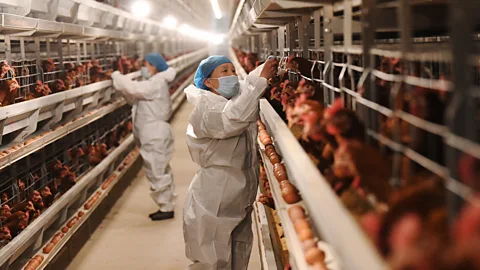 Getty ImagesFarms are being urged to deploy biosecurity measures in the wake of bird flu’s spread (Credit: Getty Images)
Getty ImagesFarms are being urged to deploy biosecurity measures in the wake of bird flu’s spread (Credit: Getty Images)
More controversial is the question of vaccinating poultry. Preventative vaccination in the most high-risk species and areas has been shown to minimise outbreaks, and WOAH advises this. Some nations, like China, already vaccinate routinely, but others have been more reluctant. Not least due to trade barriers which restrict the import of poultry and eggs from vaccinated flocks.
“When you vaccinate poultry, it’s harder to demonstrate absence of disease and early-detect its presence. So it’s posing a challenge for international trade, as everyone wants trade to be safe,” says Torres. But better surveillance can offset this risk, he adds.
Future outbreaks of HPAI could also be controlled and even prevented via reforms to global meat production, Kuiken says. A more sweeping approach could include a cap on the global poultry population size and more equitable consumption – Europe currently eats twice as much meat as global health authorities advise, Kuiken notes. (Read BBC Future’s article on sustainable sources of protein.)
How badly is wildlife affected by bird flu?
HPAI is already a pandemic in global wildlife. “With this virus, the conservation impact is already unprecedented,” says Marcela Uhart, a veterinarian at UC Davis. “It’s on a scale we’ve never seen: in terms of the number of species and regions affected, we’ve never seen anything like it.”
Of particular concern in Uhart’s home nation of Argentina, has been the virus’s spread in wild mammals. Her study into its adaptation to such mammals showed the same virus was nearly identical in fur seals and sea lions, and that many of the adaptations they detected were also present in a human case in Chile. “For all we know it could already be further adapting to spread between mammals – and we need to detect that as quickly as possible.”
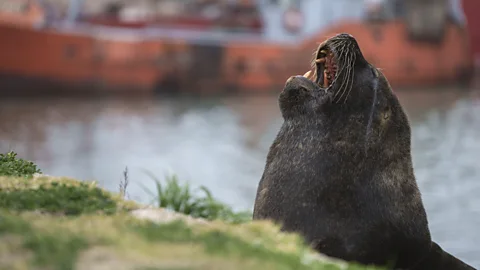 Getty imagesSea lions are among the mammals badly hit by avian influenza (Credit: Getty images)
Getty imagesSea lions are among the mammals badly hit by avian influenza (Credit: Getty images)
And while this is worrying in terms of the future impact on humans, it is also already proving devastating to other mammals: more than 17,000 elephant seals are thought to have died from the virus during the 2023 breeding season, including 70% of all the season’s pups. Since no one knows how many adults went on to die at sea from the virus, Uhart and her colleagues are now waiting apprehensively for the creatures return from the ocean this spring. If enough pregnant females come back, there will be capacity for recovery, Urhart says. If not, or if the virus hits again this year, “the impact could be major”.
“We’re all feeling very anxious about this,” Urhart says. There is pressure to keep monitoring the population-level impact on wildlife, though she says there is inadequate funding. “Everything we’re doing now is on a shoestring,” she says.
But the need to keep monitoring is key. “The removal of these species from the food chain could disrupt the whole ecosystem,” Urhart says. “A lot of what’s coming into the future is just so uncertain.”
How can we help wildlife cope with H5N1?
Reducing other pressures on wildlife could aid their survival as H5N1 becomes a new pressure on bird and mammal species. Climate change, habitat loss, bycatch in fisheries, overfishing, invasive species and pollution – via everything from plastics to pesticides – are all reducing global biodiversity. Easing those human pressures could help give populations infected by HPAI more scope to recover, says Richard Phillips, a seabird ecologist at the British Antarctic Survey.
Phillips’ work on albatrosses has shown that fishing vessels that use mitigation methods (such as not discarding fish at the same time as trawling, and using bird-scaring lines) can reduce the amount of seabird bycatch. With bird flu already hitting the vulnerable wandering albatross, Phillips fears the species’ outlook is “bleak” unless the threat from fisheries is addressed.
In the meantime, scientists will continue to track HPAI’s spread in wild populations, and find new ways to do so.
 Ben WallisMonitoring bird flu’s spread across wildlife populations is key to understanding this human-derived disaster (Credit: Ben Wallis)
Ben WallisMonitoring bird flu’s spread across wildlife populations is key to understanding this human-derived disaster (Credit: Ben Wallis)
Begeman’s expedition, for the first time, set up an entire testing laboratory on an Antarctic-bound ship. Wildlife biologists would scout sampling areas on foot for dead birds, while others would sample apparently healthy animals, she explains. Her role was to cut into the carcasses to investigate, shoo-ing away curious sheathbills as they went. “We were really like detectives, able to get to sites where people had never visited.”
The hope is that by collecting this information from the most far-flung places on the planet, scientists can inform the choices we make closer to home. For Kuiken, policy changes to reduce risk in the poultry industry are high on his list. Meanwhile, vaccination, preventative measures and conservation could all be crucial to help birds and mammals through this outbreak.

Pingback: ‘Unprecedented’: How bird flu became an animal pandemic – The Free